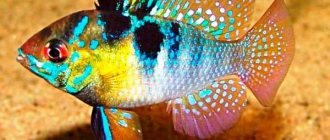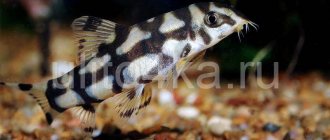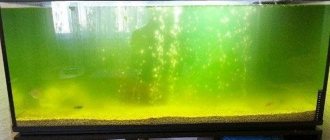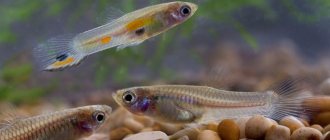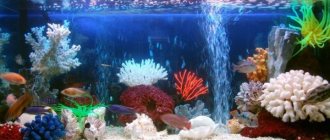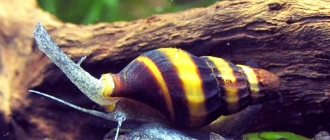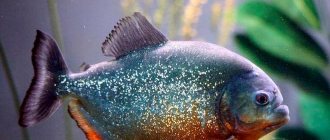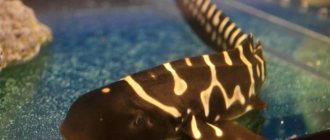“Here are collected the smallest fish that get along painlessly with shrimp. — Ideal population for nano-aquariums.
- Products in stock
- Suitable scenery, plants, invertebrates
- Suitable feed
- Articles on the topic
- Shrimp video
- Products to order
The underwater world in miniature, what could be more amazing! Fish and invertebrates of this group are tiny creatures, most of them do not grow more than 2 cm. Of course, they can be placed in a large aquarium, but it is in a small volume that it is possible to see all their beauty and grace! These peaceful fish prefer to stay in a school, feeling more confident.
Nano aquariums (aquariums from 5-10 liters) must have stable conditions: temperature +22...+25 degrees, hardness dGH 7-9, acidity pH 6.5-7.5. As well as good filtration and regular water changes. Lighting in such aquariums depends to a large extent on the presence of living plants; it is not so important for fish and invertebrates.
Keeping aquarium shrimp
Finally, we would like to draw the reader’s attention to the fact that the article provides general information. Each type of shrimp has its own characteristics and nuances. Please read separate materials about them.
Shrimp Amano
Not so long ago, in 2006, thanks to new research on Japanese shrimp, it was established that the Caridina japonica shrimp (discovered and described in 1892) and the Caridina multidentata shrimp (previously described in 1860) are the same species. Thus, since 2006, the name of the Amano shrimp has been officially changed to “Caridina multidentata”. The famous aquascaper and creator of the so-called “natural aquariums” Takashi Amano was the first to use these shrimp to combat algae in his herbal aquariums.
Having discovered their amazing ability to eat algae, he immediately ordered several thousand shrimp from a local livestock merchant. Since the 1980s, aquarists began to call it “Amano”.
Babaulti shrimp
Babaulti shrimp have a bright green body. Green babaulti shrimp have a special feature: they are able to change the color of their body, becoming either green, light brown or red. The color depends on what mood the animal is in, how it eats, and in what conditions it lives.
It is also worth noting that it is quite difficult to find well-painted Babaulti on sale, as in the pictures. Often these are tiny, pale green shrimp.
In addition, there are many color morphs of Babaulti: brown, orange and red varieties.
Blue Dream Shrimp
Blue dream shrimp do not have any special requirements regarding the decoration of the aquarium. The main thing is the presence of a certain amount of moss, plants and driftwood in the aquarium. All types of plants can be used, but small-leaved plants and mosses work best. It is recommended to build secluded places for shrimp and add oak, almond or beech leaves to the aquarium. Dry leaves are both shelter and a treat for shrimp.
Cherry shrimp
Cherry or Cherry shrimp is a species of shrimp selectively bred in Germany, obtained through a long process of crossing wild shrimp Neocaridina Heteropoda. An aquarium with this type of shrimp should be well planted with plants on which Cherry Shrimp spend a lot of their time just sitting, and be sure to have shelters in which they hide for protection, especially after molting.
Far Eastern shrimp
An almost transparent shrimp with dark transverse stripes along the body and light specks. Rostrum with straight upper and slightly convex lower margin. The single-toothed end of the beak, directed straight forward, protrudes slightly beyond the anterior edge of the scaphocerites. Of the three antennal whips of the 1st pair, two are fused together with 6-7 segments. Has small claws. The color of shrimp largely depends on the color of the food, as well as the shade of the soil. The size of the shrimp is about 5 cm.
Shrimp crystal
In 1993, the Japanese Hisayasu Suzuki, while breeding shrimp of the classic black color, accidentally received an unusual shrimp - a red shrimp. After some time, 3 more of these shrimp appeared. Deciding to fix the red gene, he began selecting and crossing shrimp with red stripes. By 1996, the breeder had several thousand red and white striped shrimp, which quickly gained popularity and love among shrimp lovers. Hisayasu Suzuki patented their name "Crystal Red".
Macrobrachium shrimp
Genus Macrobrachium - Macrobrachium. Shrimp from the genus Macrobrachium have been used in the aquarium hobby for a relatively long time. All members of the family are not peaceful. Some representatives of the genus are distinguished by their substantial size (up to 15-20 cm) and are used in gastronomy (in particular, Macrobrachium rosenbergi, which is successfully bred on an industrial scale on special farms). Fortunately for nature lovers, among the representatives of the genus there are many relatively compact creatures suitable for cultivation in home aquariums. These primarily include shrimp Macrobrachium nipponense - River, eastern Japanese shrimp. In addition to Macrobrachium nipponense, other representatives of the genus are also kept in aquariums.
Riley shrimp
Rili shrimp (Neocaridina heteropoda sp. Rili) is the fruit of selection, bred in 1996 in Taiwan, Hisayasu Suzuki - a Japanese breeder, the one who gave the world the magnificent crystal shrimp.
Here are the approximate conditions that are most favorable for keeping and breeding rili shrimp: aquarium - from 10 liters, water temperature - 22-28 degrees, pH 6.0 to 8.0 with soft to medium hard water. It is advisable to keep shrimp in a group of 10 +++ individuals; the aquarium should have rich aquatic flora - the shrimp should have shelter in the form of plants and mosses.
Glass shrimp
Glass shrimp live relatively short-lived, 1–1.5 years, and grow up to 4 cm. They are extremely easy to maintain and care for. Ghost shrimp, unlike many other relatives, are not pretentious to soft and slightly acidic water. Water parameters for their maintenance: temperature: 22-27 C, pH – 6.5-7.5, kH 5-8; gH 5-8, dH – 4-8; TDS – 120-180. Weekly water changes are required. Aeration and water filtration are also necessary. You need to create places in the aquarium where ghosts can hide. This could be snags, thickets of plants, a pile of stones, etc.
Sulawesi shrimp - cardinals
The habitat of the Cardinal shrimp is the rocky areas of the lake on the island of Sulawesi in Indonesia. Its size is on average one and a half centimeters. They are very active in obtaining food from bottom stones and algae, as well as from snail shells from their native island. Therefore, their home should have an abundance of such decorative elements as aquarium plants, stones, aquarium driftwood and other objects overgrown with algae. The color intensity of the Cardinal shrimp is in no way related to the sex, age, emotional or physical state of the individual. The body color is various shades of cherry and red, contrasting attractively on the sides with white spots that may be edged in blue. A characteristic feature is the white front legs, which the crustacean quickly and amusingly moves while getting food.
Shrimp filter feeder
The filter feeder shrimp, unlike other shrimps, is clumsy, if I may say so, clumsy. She will not jump around like a flea throughout the aquarium and the reason for this is the way she feeds. The filter-feeding shrimp feeds by means of fan-shaped cilia, which are located on its claws. With them, the shrimp catches “goodies in the wind” - microorganisms, small particles of fish food, plant remains, etc. To do this, the shrimp climbs to the most “blown place” - the place where the flow from the filter is as intense as possible and spreads its fans there. As soon as the food has entered the fan, it is brought to the mouth. This is actually why the filter feeder shrimp has a conditional clumsiness - its heavy body and tenacious legs are adapted to stand spread apart with the flow. See also Gabon filter feeder shrimp .
Black tiger shrimp
The Black Tiger Shrimp, also known as the Black Diamond Shrimp, mainly in Japan, is becoming a very popular species among modern shrimp breeders. This species was selectively bred from the common Tiger Shrimp, where, over a long period of time, specimens with the most black stripes were selected for crossing, in the end, the selection gave the long-awaited result and the shrimp became completely black. There are two varieties of Black Tiger Prawn - one with black eyes and the other with orange eyes. Moreover, those with orange eyes are valued much higher than their black-eyed relatives.
